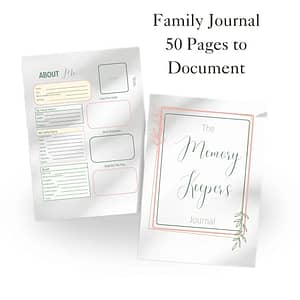Record Your Family’s Lore in a Living Legacy to pass down to future generations.
Everyone loves family stories – the kind that whisper through generations, carried on the breath of ancestors, and shaped by the unique tapestry of each family. More than just names and dates on a dusty old document, our family histories are vibrant collections of lore, legends, quirks, and wisdom. And what better way to honor these precious gifts than by creating a living family journal – a tangible testament to the tales that make you, you?
In our increasingly fast-paced world, it’s easy for these invaluable stories to get lost, like whispers on the wind. But imagine, for a moment, being able to trace the threads of your family’s narrative, not just through official records, but through the vibrant, often hilarious, and sometimes deeply poignant anecdotes that truly define your lineage. That’s the magic of a family journal.
More Than Just a Record It’s A Tapestry of Tales
Think of your family journal not as a dry historical account, but as an ever-evolving storybook, penned by the hands of those who came before you and continued by your own. It’s a place to record the tall tales, the inside jokes, the curious superstitions, and the unforgettable characters that have shaped your family’s history.
My own family, for instance, has a legendary tale about my husband’s mom. Apparently, she was convinced that if you left a slice of apple pie on the windowsill on a full moon, the “pie fairies” would bless your garden with an abundance of tomatoes. To this day, whenever someone in our family has a bumper crop of tomatoes, we wink and say, “Ginny’s pie fairies must have been busy!” Of course we will never forget the one time the boys snuck up to the window ledge and helped themselves to the pie and you better believe mom was having them pick switches for when daddy got home.

Capturing Wisdom and History
But a family journal isn’t just for the funny anecdotes. It’s also a sacred space for recording the wisdom passed down, the challenges overcome, and the historical events that shaped your ancestors’ lives. Did your great-grandparents immigrate during a turbulent time? What were their hopes and fears? Did they have any unique traditions or customs they brought with them?
Consider the practical skills that might be lost if not recorded. Perhaps your grandmother had a secret recipe for the most comforting banana bread, or your grandfather had a particular way of telling the weather by observing the clouds. These small details, when captured, become invaluable treasures for future generations.
Use Today’s Technology
When the family gets together for the holidays or special occasions, bring out your phone and record all those stories that are being reminisced about. We have a family dinner once a month and the stories that get told are priceless.
Starting Your Journey By Building Your Family Tree
Before you can delve into the fascinating stories, it’s often helpful to establish the framework of your family – the family tree. This visual representation of your lineage serves as a roadmap, guiding you through the branches and roots of your heritage.
Here’s how to begin building your family tree:
- Start with Yourself: Begin with your name, birth date, and place of birth.
- Move to Your Parents: Add your parents’ names, birth dates, places of birth, and marriage information.
- Go Backwards, Generation by Generation: Continue this process for your grandparents, great-grandparents, and so on, filling in as much information as you know. Don’t worry if there are gaps – that’s where the detective work begins!
- Gather Information: Talk to older family members! They are often a goldmine of information, photos, and stories. Look through old photo albums, birth certificates, marriage licenses, and obituaries.
- Utilize Online Resources: Several excellent websites can help you trace your lineage and connect with distant relatives.
- Ancestry.com: One of the largest and most comprehensive genealogy sites, offering access to billions of historical records, family trees, and DNA testing.
- FamilySearch.org: A free resource provided by The Church of Jesus Christ of Latter-day Saints, boasting an extensive collection of genealogical records and helpful research tools.
- MyHeritage.com: Offers family tree building, historical records, and DNA testing, with a strong focus on international records.
- Findmypast.com: Particularly strong for UK and Irish records, but also has a growing collection of international records.
- New England Historic Genealogical Society (AmericanAncestors.org): A fantastic resource for American genealogical research, especially for early American families.
Filling Your Journal with Life: Tips and Tricks
Once you have a basic family tree established, you can begin to breathe life into it with your journal entries.
- Interview Relatives: This is perhaps the most crucial step. Sit down with your parents, grandparents, aunts, and uncles. Ask open-ended questions:
- “What’s your earliest memory?”
- “What was life like when you were growing up?”
- “Do you remember any funny stories about [ancestor’s name]?”
- “What traditions did your family have?”
- “What challenges did your family face?”
- “What advice would you give to future generations?”
- Record these conversations, either by writing them down, using an audio recorder, or even filming them (with permission, of course!).
- Document Everyday Life: Don’t just focus on the grand narratives. Record the small, everyday details that make your family unique. What are your family’s favorite holiday traditions? What are the special dishes passed down through generations? What sayings or expressions are unique to your family?
- Include Photos and Memorabilia: A picture is worth a thousand words. Include old photographs, letters, postcards, newspaper clippings, or even drawings that relate to your family’s stories. You can glue them in, or if you prefer a digital journal, scan them and embed them.
- Write in Your Own Voice: This is your family’s journal, so let your personality shine through. Don’t feel pressured to write in a formal, academic style. Be authentic and heartfelt.
- Encourage Contributions from Others: Make it a collaborative effort! Invite other family members to contribute their own memories, stories, and photographs. This will make the journal even richer and more comprehensive.
- Regularly Update: A family journal is a living document. Make it a habit to add to it regularly, whether it’s once a week, once a month, or whenever a new story surfaces.
The Enduring Gift
Creating a family journal is more than just a hobby; it’s an act of love, a profound gift to future generations. It’s a way to ensure that the whispers of yesteryear don’t fade into silence, but instead echo vibrantly through the ages, reminding us of who we are, where we come from, and the remarkable journey our families have taken.
So, gather your stories, unearth your legends, and begin weaving your family’s unique tapestry. You’ll not only preserve the past but also create a legacy that will inspire and connect your family for generations to come. Happy journaling!
For The Memory Keeper In Your Family
To make your journaling easier, we have created a 50 page Memory Keepers Family Journal for you to use to document all kinds of things. It includes pages for your family tree, family photos, family trips, prayer list, bucket lists, medical information, birthdays and so much more! Download a free copy in our Piper’s Hollow Resource Library. Need the secret password? No worries, just join the community below and it will be on its way to you!

